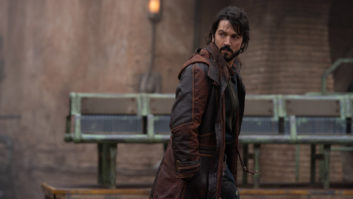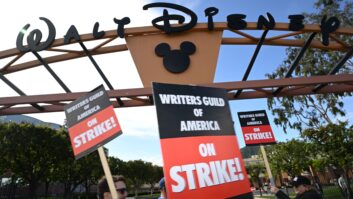Earlier this week, Videndum (formerly Vitec) issued a profits warning, stating that it expects to see short-term demand for its products fall due to the writers’ strike in the United States.
TV and film production is on hold after the Writers’ Guild of America, which combines two different US labour unions representing TV and film writers in New York and Los Angeles, called a strike on Tuesday.
The union represents more than 11,500 writers across film, television and other entertainment forms and has been in negotiations with the Alliance of Motion Picture and Television Producers (AMPTP), which represents the film and TV production arms of companies like Disney, Netflix and Amazon. The WGA argues that writers have been negatively impacted by the streaming era and that studios including the major streamers, have “created a gig economy inside a union workforce” according to a statement released earlier this week.
The strike has already impacted the late-night US chat shows, which have all gone on hiatus. Some current UK-based productions are also feeling the effect. The Lord of the Rings: The Rings of Power, currently filming at Bray Studios, will finish shooting its second season without its showrunners, who are both supporting the strike.
The last major writers’ strike lasted for 100 days, from November 2007 until February 2008. If that happens again, it could easily have an impact on the production industry in terms of the technology being bought or rented for production.
According to Fred Black, principal analyst at Ampere Analysis, two things will determine the strike’s impact: “Firstly, how long the strike takes to resolve. And secondly, how big an impact on the profitability of streaming services the conclusion has,” Black tells TVBEurope.
“Streaming services are under increased pressure to reach profitability, or at least show a clear path to get there. That’s seen cost-cutting measures already, with the number of TV shows being commissioned drastically reduced, major job cuts, and the introduction of new monetisation methods like Netflix’s ad tier. That’s a tricky environment for these companies to consider paying writers substantially more for their work.”
Black says the short-term impact of the strike is likely to be relatively limited, but should it continue into the summer then viewers will start to see the consequences, with premiere dates for the autumn pushed back, and increasingly severe impacts on the number of episodes produced for shows in the 2023-24 season.
“That’s bad news for those companies involved,” he continues. “While broadcast TV audiences are ebbing away, it’s still very profitable, and these companies are invested in keeping it that way for as long as possible. One thing we saw over the pandemic is that when audience habits shift due to an extreme event, they never return to exactly how they were – some ground may be recovered but not all of it.”
Streaming platforms are likely to face less short-term issues as their content is produced further in advance of release, and the majority of content set to debut coming months is likely to already be in the can.
Asked if media companies can prepare themselves for issues brought about by the strike, Black says they absolutely can. But, those plans should have already been in place. “This strike has been on the cards for a while, negotiations have been ongoing for months,” he explains.
“There have been plenty of early renewals at broadcast networks, allowing scripts to be written before the strike took effect, while unscripted content has been commissioned to cover gaps, and can continue to be produced throughout. Another solution that [broadcasters and streamers] can use is commissioning outside of the US. While US writers couldn’t work on productions that simply switch base to London, projects from other countries are unaffected. Streaming services are already localising, and those that produce more of their content outside of the US will weather a local strike more easily. If the strike drags on, you may see streamers move even further in an international direction.”
Black warns of another possible issue over the summer that companies should be preparing for now. The Directors and Screen Actors Guilds are due to open negotiations with AMPTP shortly ahead of a deadline of June 30th. “Without writers, the industry can keep the lights on for a few months at least. Without actors or directors either, we have a true production shutdown,” he says.
For an industry still feeling the after-effects of the pandemic, and which has been looking to cut costs while gaining subscribers, a strike that runs long enough to impact original content supplies would be a huge problem. “Sitting least comfortably are companies still reliant on broadcast TV’s profits, which will see them more rapidly exposed,” says Black.
“On the flipside, companies whose audience is primarily interested in reality TV, or those with investment in live sports (which will be unaffected), will be less exposed than those who are scripted-focused,” he continues.
“Within streaming, some platforms may be better stocked with completed content that’s ready to go, or foreign commissions that will draw in an audience. Ultimately however, the fact that the major companies are negotiating together via the AMPTP mitigates the risk, with rivals unable to steal that much of a march. Companies will likely bite the bullet and resolve the strike before anybody gets into real trouble.”







